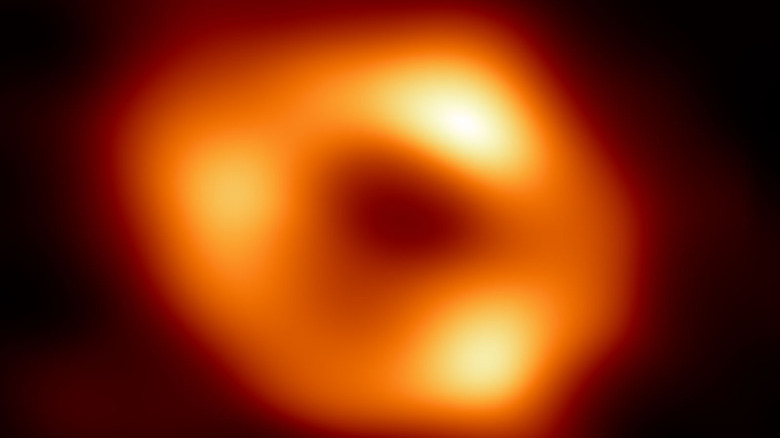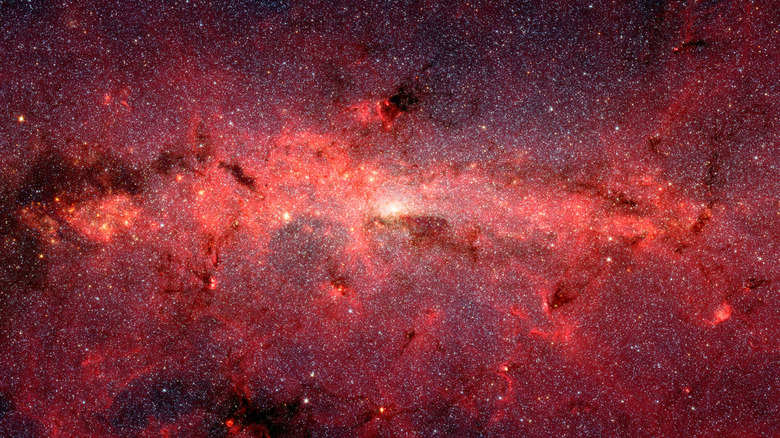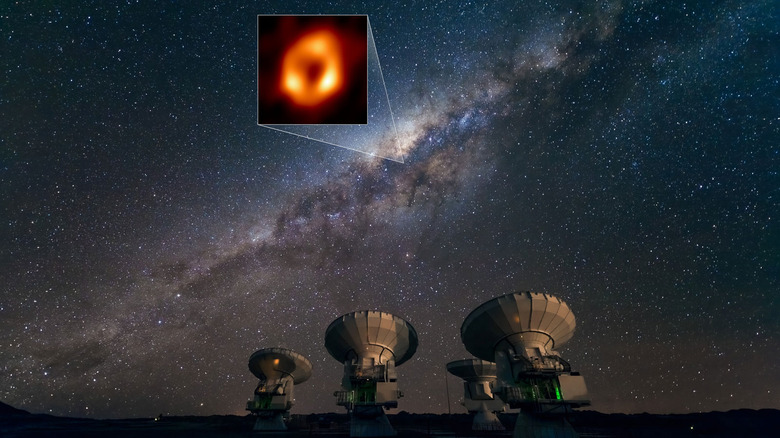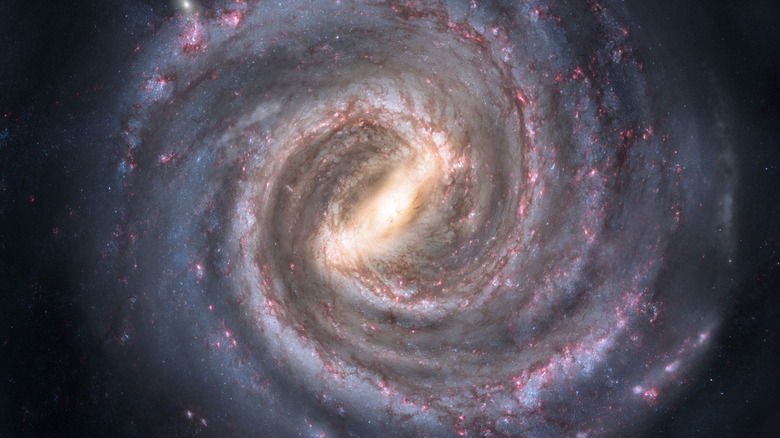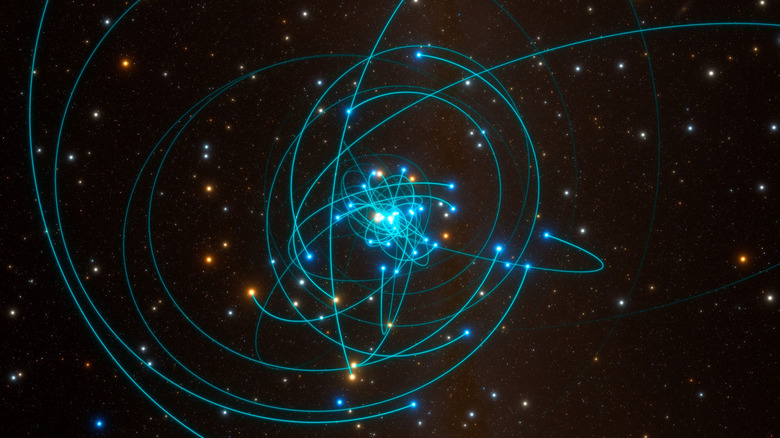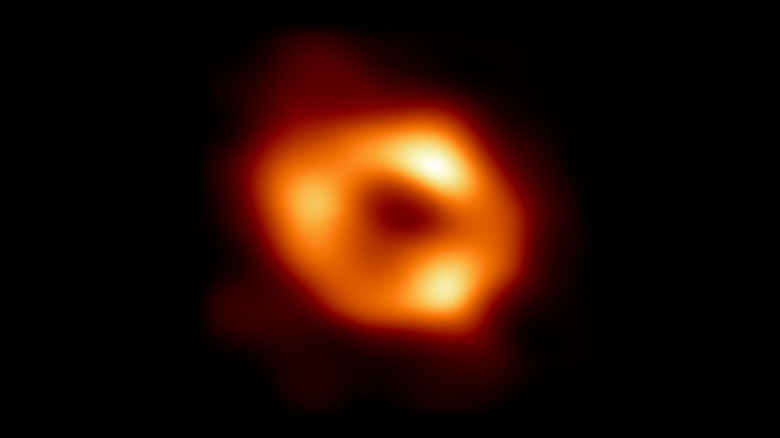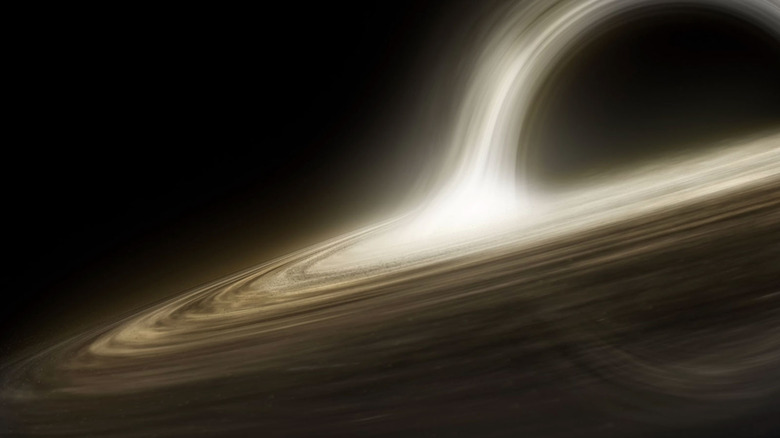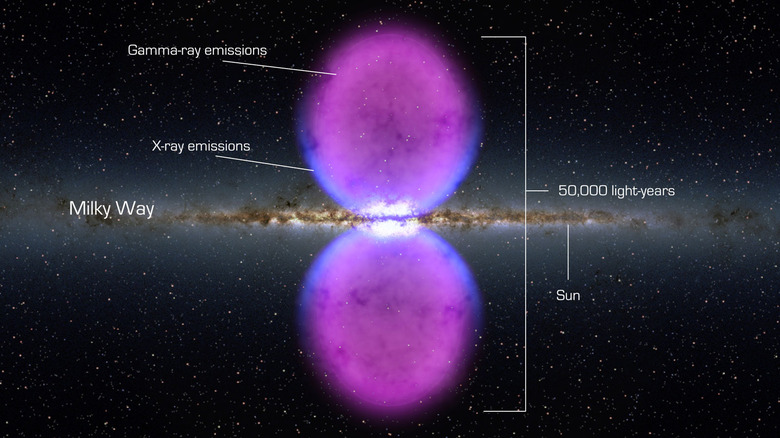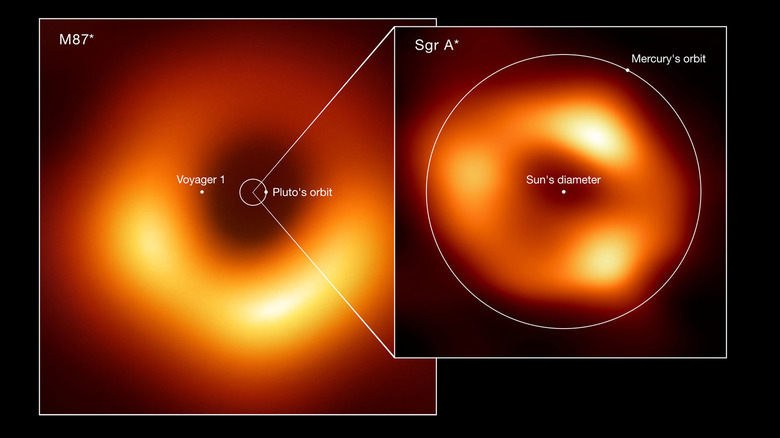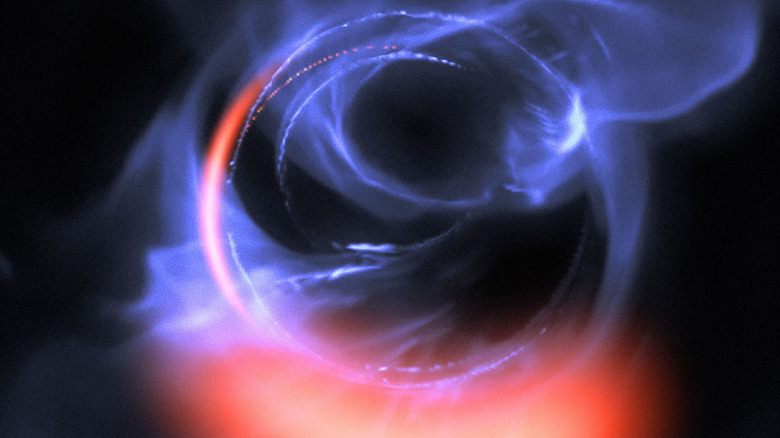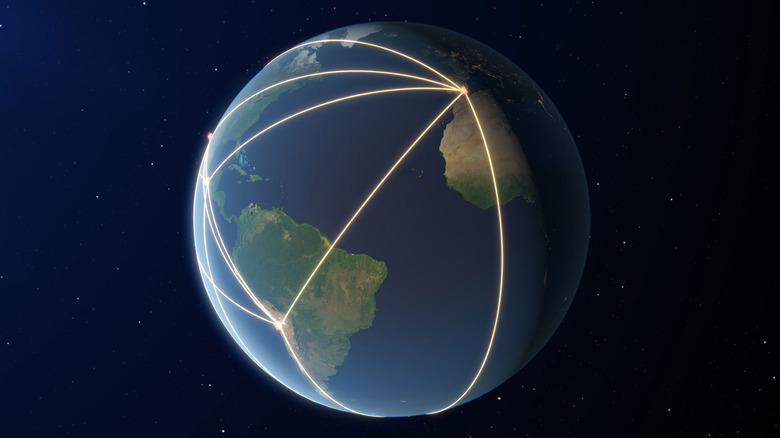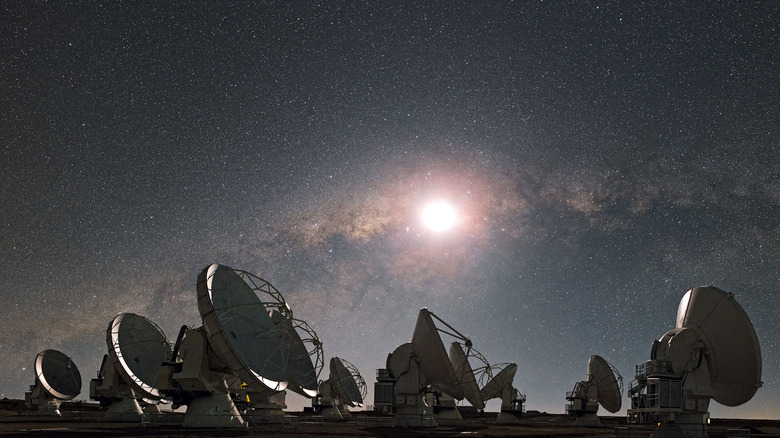Everything We Know About The Milky Way's Black Hole
Astronomers have known for a long time that the center of our galaxy, the Milky Way, contains a black hole, but until 2022, there was no direct proof of this. Thanks to the Event Horizon Telescope, this is no longer the case, and the world now has visual proof of the Milky Way's black hole, seen using radio waves. While this blurry-looking image may seem uninspiring at first, it's truly breathtaking to realize not only the reality of what this picture shows, but also the overwhelming effort which went into acquiring it.
The Milky Way's central black hole is known as Sagittarius A* (pronounced A-star). Unimaginably dense, black holes exert such extreme forces of gravity, warping the fabric of spacetime so much, that everyday physics is put to the test. This makes the opportunity to study one extremely exciting. So much so, that a worldwide collaboration of researchers has been working hard to take a closer look at Sagittarius A*, involving over 300 scientists working at 80 research institutes.
The images of Sagittarius A* are an exceptional breakthrough, following in the wake of the 2020 Nobel Price for Physics. This was awarded in part to Reinhard Genzel and Andrea Ghez, two veteran black hole hunters. As Space.com explains, their research found conclusively that our galaxy's dark heart is so dense that it couldn't be anything other than a black hole.
The Galaxy's supermassive heart
Supermassive black holes are strange beasts. Sagittarius A*, as an ESO information page explains, contains the mass of over four million Suns. Even though it's so massive, it's physically surprisingly small. An ESO press image illustrates this, showing how Sagittarius A* is small enough that it would comfortably fit inside the orbit of Mercury, here in our solar system. This is an absurd amount of matter packed into a such a small volume. The result is the monstrously strong gravitational field which makes black holes so fascinating to scientists.
Nestled deep inside the Milky Way's galactic core, this small size is what makes Sagittarius A* so difficult to observe, but the distance also complicates things. The heart of the galaxy, as an ESO press release notes, lies 27,000 light-years away from Earth. In other words, the radio waves which astronomers used to see the black hole have been traveling through space for millennia. The new images show our galaxy's black hole the way it appeared when people were still living in the oldest known permanent human settlement (via The Australian Museum).
Remarkably, in some ways, Sagittarius A* looks very much the way astronomers expected it to. As theoretical physicist Mariafelicia de Laurentis notes during the ESO press conference that its size is a close match with predictions, being within 10% of the size that General Relativity predicted. Albert Einstein's theory, so it seems, is as accurate as ever.
A hidden dragon
As well as its surprisingly small size, a big challenge to seeing Sagittarius A* is where it's located. Simply put, there's a lot of galaxy blocking the view. As the University of Alabama explains, the galactic center is one of the busiest parts of the sky, dense with stars and full of vast, trailing clouds of interstellar dust. Known as dust lanes, they're dense enough to appear as dark patches across the starry night sky, blocking out starlight.
The galactic core itself is littered with a complex collection of even denser interstellar clouds and the drifting remains of supernovae. An image by the National Radio Astronomy Observatory shows a map of the region, taken using radio astronomy to see through all of the galaxy's gas and dust. As a paper in the journal Astronomy & Astrophysics discusses, some of these dusty expanses are dense enough to form an array of complex molecules, like the hulking Sagittarius B2 cloud. But it's the cloud at the very center of the galaxy, Sagittarius A, that hides the supermassive black hole.
Encircling Sagittarius A* itself is a disk of material light years in diameter. As Space.com explains, this is known as an accretion disk, made up of everything which has been swept up by the black hole's gravity. Gathered gas and dust joins matter torn from any hapless stars which stray too close. This accretion disk, burning hot from friction, slowly drip-feeds Sagittarius A*, causing flashes of x-rays as it does.
Hunting for monsters
Black holes were first predicted by Einstein's now-famous theory of General Relativity, published in 1915, as Space.com notes. Over the following century, astronomers would go on to uncover fragments of information that slowly proved that black holes really do exist. One of the earliest discoveries was made by an astronomer named Karl Jansky. Jansky, as the Armagh Observatory and Planetarium explains, is popularly known as the father of radio astronomy, pioneering the techniques used by the Event Horizon Telescope. It was also Jansky who first found signs of radio emissions coming from the galaxy's core.
Decades later came the actual discovery of Sagittarius A*. A conference paper from the Proceedings of the Galactic Center Workshop 2002 explains that, in 1974, the astronomers Bruce Balick and Robert L. Brown were the first to observe it, using the famous Green Bank radio observatory, recording it as a "compact radio source." Later, in 1982, Brown was the one who coined the name Sagittarius A*.
Before astronomers could observe it directly, studies focussed on watching the powerful gravitational effects of the black hole, as it's orbited by nearby stars. As explained by Robert McNees, a physicist at Loyola University Chicago, astronomers have spent decades watching the orbits of these stars to trace their paths around Sagittarius A*.
Flinging stars like marbles
The gravitational forces exerted by Sagittarius A* are absurdly strong. So powerful that it can accelerate stars far larger than the Sun to blistering speeds. A paper in Astronomy & Astrophysics discusses one such massive star, known only as S2. Locked into an uncomfortably close orbit around Sagittarius A*, it completes one full orbit every 16 years, reaching dizzying speeds of 7,650 kilometers per second. According to Wolfram Alpha, that's 17 million miles per hour, and around 2.5% the speed of light!
S2 isn't even the fastest star to be seen orbiting Sagittarius A*, however. In 2020, astronomers caught sight of another star, named S4714, as it broke the record for the fastest star ever seen. Anything straying close enough to the black hole gets a powerful speed boost, thanks to gravity, and Space.com recounts the story of how S4714 was accelerated to 8% the speed of light.
At such outrageous speeds, Sagittarius A* can even fling stars right out of the galaxy. Astronomers have occasionally seen these unfortunate stars on their doomed paths towards the vast voids of intergalactic space, ejected with a gravitational slingshot from the most massive single object in the Milky Way. One is discussed by a paper in The Astrophysical Journal, traveling at a velocity of 853 kilometers per second — dramatically faster than the escape velocity of the Milky Way.
Staring right at us
Perhaps the most surprising thing astronomers have learned about Sagittarius A* is that it appears to be pointing in our direction. As astrophysicist Christian M. Fromm explains during the ESO press conference, astronomers have officially confirmed that Sagittarius A* is spinning on an axis, in much the same way that stars and planets do. As Fromm notes, it appears to be seen face-on, meaning that the rotational axis is pointing roughly towards our part of the galaxy.
It may seem a little confusing, that Sagittarius A* doesn't rotate in the same direction as the rest of the galaxy, but it turns out that this isn't as bizarre as it sounds. Sera Markoff, professor of theoretical high energy astrophysics, elaborates on this during the public Q&A session. The rotational axis of a black hole is actually quite random over long timescales. During the history of a supermassive black hole, it may encounter other objects, steadily feeding and growing to its colossal size. The way it spins can be changed as it steals matter from nearby stars or, more dramatically, if it collides with other black holes. These events release a prodigious amount of energy (via National Geographic), enough to shift the axis of a black hole like Sagittarius A*. With such a long history, it's had plenty of time for events like these to change the way its axis points.
The starving giant
Many people have the impression of black holes as something like the plughole of a bathtub, sucking in everything around them. In reality though, black holes aren't nearly so ravenous. Sagittarius A*, in fact, barely seems to eat anything at all. During the ESO press conference, astrophysicist Sara Issaoun describes it as like a human eating only a single grain of rice every million years. Seemingly, our galaxy's black hole has remarkably restrained eating habits.
That said, Sagittarius A* will still devour anything which strays within reach. And when it does, astronomers notice. In 2019, as The Guardian reports, it showed a sudden flurry of activity as it feasted hungrily at a rate that had never been seen before. The most likely cause was a hapless star straying too near. One star, named S0-2, was very close to the maw of Sagittarius A* at the time, and it may have lost a huge amount of gas to the black hole's gravitational grip. Light stellar snacks like these are probably the bulk of Sagittarius A*'s diet.
As theoretical astrophysicist Sera Markoff notes during an ESO public Q&A session, the black hole is seemingly being drip-fed by a few stray stars which are unfortunate enough to be nearby. Their misfortune, however, is exactly what allowed Sagittarius A* to be seen. As astrophysicist Christian M. Fromm notes during the ESO press conference, it's the glow of material falling into the black hole that can be seen by radio telescopes.
Echoes of a violent past
Sagittarius A* may be quite placid for the time being, but there are signs it wasn't always so reserved. During the ESO public Q&A session, theoretical astrophysicist Ziri Younsi points out what could be evidence of cataclysmic past events in the history of our galaxy. Extending high above and below the disk of the Milky Way are two immense patches of hot gas known as Fermi bubbles.
As Space.com explains, the Fermi bubbles were first discovered in 2010 by NASA's Fermi Space Telescope. Extending out 25,000 light years from the galactic core, the Fermi bubbles emit vast amounts of gamma radiation. And no one's entirely sure what they are or where they came from. One possible origin is that they're the end result of Sagittarius A* eating a mammoth meal and belching out a huge blast of energy in the process.
As the Fermi telescope website notes, it's not uncommon for the supermassive black holes contained in other galaxies to devour huge amounts of matter, causing them to send out huge, high-energy jets of material. It's possible that, at some point in the past, Sagittarius A* did the exact same thing, shooting columns of hot matter out into intergalactic space. If so, the Fermi bubbles could be the lingering smoke from a galaxy-sized gun. For now, there's no way of knowing.
Supermassive but pint-sized
Sagittarius A* is surprisingly small for a supermassive black hole. In fact, it's like a kitten compared to some of the black holes lurking in the hearts of other galaxies. The Event Horizon Telescope has so far taken an image of only one other supermassive black hole, name M87* and, as an MIT press release explains, M87* is 1,500 times larger, with a mass of 6.5 billion Suns. As the ESO press image shown here illustrates, while Sagittarius A* could comfortably fit inside the orbit of Mercury, M87* could easily swallow every planet in our entire Solar system as a light snack.
Even M87* is far from the largest of its kind. So far, as Astronomy Magazine explains, the record is held by a supermassive black hole in a distant galaxy cluster known as Abell 85. Positively gargantuan, this black hole weighs in at 40 billion solar masses. It's roughly the size of the Solar system but contains as much mass as two-thirds of the stars in the Milky Way galaxy.
True titans like these are rare, but they certainly highlight how diminutive Sagittarius A* really is, at "only" 4 million solar masses. With its docile demeanor, our galaxy's black hole seems unlikely to grow to such mammoth proportions anytime soon. As a NASA news feature explains, Sagittarius A* stays mostly dormant. For now, it only occasionally wakes up for a light meal, even though it may have been far more active in the past.
Blazing in the dark
While Sagittarius A* may not be actively feeding on anything, it does occasionally emit brilliant flares. As a NASA press release explains, these are high energy outbursts, sending out bright x-rays. Some of these flares can be hundreds of times brighter than the black hole's usual quiet state. Astrophysicists Roman Gold and Sera Markoff discuss this during an ESO public Q&A, explaining how these flares tend to happen as clumps of material fall into the black hole and seemingly come from the very edge of the black hole's event horizon – the point of no return for anything falling in. The resulting flickers and flares pose quite a challenge to astronomers trying to model and observe Sagittarius A*, and this is on top of a constant bubbling variability which the black hole always shows.
An ESO press release elaborates, noting that these flares are most likely a result of superheated gas caught in magnetic fields around the black hole. Far from being silent and static, Sagittarius A* is seemingly a vibrant and ever-changing beast. In the same ESO Q&A session, radio astronomer Rocco Lico mentions that all of this made Sagittarius A* difficult to capture images of, because it's constantly moving and changing even while being watched.
The eyes of Earth
Taking a portrait of a supermassive black hole was only possible thanks to the Event Horizon Telescope, a remarkable achievement in itself. The telescope is the result of a worldwide collaboration, currently involving 11 different observatories worldwide. As radio astronomer Thomas R. Krichbaum explains during the ESO press conference, these are linked together using a technique known as Very Long Baseline Interferometry. Simply speaking, this allows several different observatories to work together as a single super-telescope. With the different parts of the Event Horizon Telescope in places as far apart as Antarctica, Greenland, and Hawai'i, it effectively becomes a single telescope as large as the Earth itself. Being so large, it has exceptional resolution, with such keen vision that it would reportedly be able to spot a doughnut on the surface of the moon.
Carefully synchronized using atomic clocks, data can be recorded across the Earth at the exact same time. The challenge doesn't stop there, however. As Leiden Observatory's Violette Impellizzeri explains during the ESO public Q&A, each recording gathers so much data that it's impractical to try and send over the internet. It's actually faster to physically send the data in the mail, even with one of the observatories being located at the South Pole.
Looking ever closer
The Event Horizon Telescope's images of Sagittarius A* are groundbreaking, but they're still little more than a tantalizing glimpse at one of our galaxy's most interesting locations. There's still plenty more to learn about it, and astronomers are already eager to keep looking. Professor Sera Markoff explains, in the ESO Q&A, that there's a lot about Sagittarius A* which is still poorly understood. In particular, the flares emitted by the black hole are a puzzle. Astronomers have studied other black holes, both inside the Milky Way and in other galaxies, and no others seem to emit flares like these. Sagittarius A*, it seems, is something of an oddball. Perhaps, by looking closer at how it interacts with its surroundings, astronomers can learn more about why it's such a misfit.
There are already plans for how to further improve the Event Horizon Telescope to capture even more detailed images. Astronomer Violette Impellizzeri speaks enthusiastically about adding a new frequency to the radio telescope observations, which will allow them to pick out even finer details. The Max Planck Institute's Michael Janssen elaborates further, on how current observations are constrained by the size of the Earth. The solution, further into the future, is to use space telescopes in orbit around the Earth, improving the accuracy even further. For now, the sky is the limit, but that will not always be the case.
